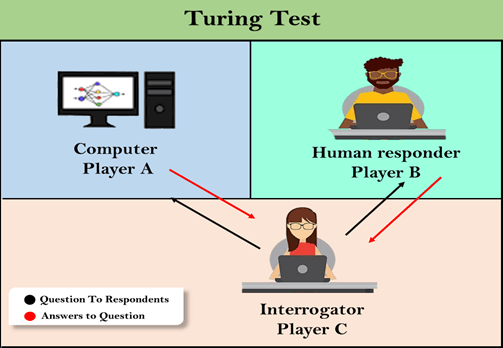Turing Test in AIIn 1950, Alan Turing introduced a test to check whether a machine can think like a human or not, this test is known as the Turing Test. In this test, Turing proposed that the computer can be said to be an intelligent if it can mimic human response under specific conditions. Turing Test was introduced by Turing in his 1950 paper, "Computing Machinery and Intelligence," which considered the question, "Can Machine think?"  The Turing test is based on a party game "Imitation game," with some modifications. This game involves three players in which one player is Computer, another player is human responder, and the third player is a human Interrogator, who is isolated from other two players and his job is to find that which player is machine among two of them. Consider, Player A is a computer, Player B is human, and Player C is an interrogator. Interrogator is aware that one of them is machine, but he needs to identify this on the basis of questions and their responses. The conversation between all players is via keyboard and screen so the result would not depend on the machine's ability to convert words as speech. The test result does not depend on each correct answer, but only how closely its responses like a human answer. The computer is permitted to do everything possible to force a wrong identification by the interrogator. The questions and answers can be like: Interrogator: Are you a computer? PlayerA (Computer): No Interrogator: Multiply two large numbers such as (256896489*456725896) Player A: Long pause and give the wrong answer. In this game, if an interrogator would not be able to identify which is a machine and which is human, then the computer passes the test successfully, and the machine is said to be intelligent and can think like a human. "In 1991, the New York businessman Hugh Loebner announces the prize competition, offering a $100,000 prize for the first computer to pass the Turing test. However, no AI program to till date, come close to passing an undiluted Turing test". History of Turing TestThe Turing Test, introduced by Alan Turing in 1950, is a crucial milestone in the history of artificial intelligence (AI). It came to light in his paper titled 'Computing Machinery and Intelligence.' Turing aimed to address a profound question: Can machines mimic human-like intelligence? This curiosity arose from Turing's fascination with the concept of creating thinking machines that exhibit intelligent behavior. He proposed the Turing Test as a practical method to determine if a machine can engage in natural language conversations convincingly, making a human evaluator believe it's human. Turing's work on this test laid the foundation for AI research and spurred discussions about machine intelligence. It provided a framework for evaluating AI systems. Over time, the Turing Test has evolved and remains a topic of debate and improvement. Its historical importance in shaping AI is undeniable, continuously motivating AI researchers and serving as a benchmark for gauging AI advancements. Variations of the Turing TestOver the years, different versions of the Turing Test have appeared to overcome its constraints and deliver a more thorough assessment of AI capabilities:
Chatbots to attempt the Turing test:ELIZA: ELIZA was a Natural language processing computer program created by Joseph Weizenbaum. It was created to demonstrate the ability of communication between machine and humans. It was one of the first chatterbots, which has attempted the Turing Test. Parry: Parry was a chatterbot created by Kenneth Colby in 1972. Parry was designed to simulate a person with Paranoid schizophrenia(most common chronic mental disorder). Parry was described as "ELIZA with attitude." Parry was tested using a variation of the Turing Test in the early 1970s. Eugene Goostman: Eugene Goostman was a chatbot developed in Saint Petersburg in 2001. This bot has competed in the various number of Turing Test. In June 2012, at an event, Goostman won the competition promoted as largest-ever Turing test content, in which it has convinced 29% of judges that it was a human.Goostman resembled as a 13-year old virtual boy. The Chinese Room Argument:There were many philosophers who really disagreed with the complete concept of Artificial Intelligence. The most famous argument in this list was "Chinese Room." In the year 1980, John Searle presented "Chinese Room" thought experiment, in his paper "Mind, Brains, and Program," which was against the validity of Turing's Test. According to his argument, "Programming a computer may make it to understand a language, but it will not produce a real understanding of language or consciousness in a computer." He argued that Machine such as ELIZA and Parry could easily pass the Turing test by manipulating keywords and symbol, but they had no real understanding of language. So it cannot be described as "thinking" capability of a machine such as a human. Features required for a machine to pass the Turing test:
Limitation of Turing Test
ConclusionThe Turing Test still serves as a pivotal benchmark for assessing AI's conversational skills in today's context. It continues to be instrumental in the development and evaluation of chatbots and virtual assistants. Many companies and developers employ different versions of the test to gauge how well their AI systems can engage in conversation. However, it's worth noting that while the Turing Test maintains its relevance, the AI field has progressed significantly beyond its scope. Modern AI systems leverage advanced natural language processing, machine learning, and deep learning techniques, empowering them to execute tasks much more intricate than imitating human dialogue. AI's applications now span a wide array of fields, from healthcare and finance to autonomous vehicles and image recognition, showcasing its diverse capabilities that extend well beyond mere conversation.
Next TopicSearch Algorithms
|
 For Videos Join Our Youtube Channel: Join Now
For Videos Join Our Youtube Channel: Join Now
Feedback
- Send your Feedback to [email protected]
Help Others, Please Share









